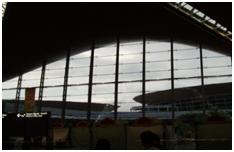I believe everybody is familiar with the term of ‘CPU’ or ‘processor’. When we discuss about purchasing a new Personal Computer (PC), laptop or notebook, the speed of the CPU will be our priority, subsequently of course its price. Thus, the performance of the CPU becomes our essential attention before deciding to buy. Microprocessor actually is another term for CPU or processor. It is just a single chip, is designed to be a brain on a motherboard and needs fan to cool its system. Even though its size is smaller than a motherboard, it is capable of reading binary instructions from a storage device called memory, accepts binary data as input and processes data according to those instructions, makes decisions and provides results as output [1]. It is a semiconductor device (integrated circuit) that is manufactured by using the large-scale integration technique [1]. It has three (3) main internal components: Register Array, Arithmetic and Logic Unit (ALU) and Control Unit (CU).
 | ||
Intel 4004 First microprocessor was invented
|
Besides the CPU and motherboard, we require a hard disc and RAM with higher capacity such as 500GB and 4MB respectively to complete our new PC. We also buy a mouse, a monitor and a keyboard. In fact, a PC is so called a microprocessor-based system or a microcomputer system. A microcomputer system consists of a CPU/processor/microprocessor, memory, input output (I/O) and bus systems as depicted in Figure 2. Bus systems compose to address bus, data bus and control bus.
Advances in semiconductor technology have developed since last 40 years, from SSI (Small-Scale Integration) to LSI (Large-Scale Integration) and it gives impact on computers certainly, from large computers to single-chip microcomputers. With the advancement of the semiconductor technology, it is possible to design a microcomputer into a single chip and so called a microcontroller.
Different types of computers are designed to serve different purposes. General purpose computer is a type of a microprocessor-based system where the main components of a microcomputer system are designed separately. Its functions can be simply changed by changing a program [3]. Followings are the example of microprocessor-based system applications.
¡ PC/laptop/notebook/netbook
¡ Mainframe - powerful computers used primarily by corporate and governmental organizations for critical applications, bulk data processing such as census, industry and consumer statistics, enterprise resource planning, and financial transaction processing.
¡ Workstation
- high-end microcomputer designed for technical or scientific applications. Intended primarily to be used by one person at a time, they are commonly connected to a local area network and run multi-user operating systems. The term workstation has also been used to refer to a mainframe computer terminal or a PC connected to a network. http://en.wikipedia.org/wiki/Workstation
 |
¡ Server - physical computer (a hardware system) dedicated to running one or more such services (as a host) to serve the needs of users of the other computers on the network.
 |
| http://en.wikipedia.org/wiki/Server_(computing) |
¡ Supercomputers
- used for highly calculation-intensive tasks such as problems including quantum physics, weather forecasting, climate research, molecular modeling (computing the structures and properties of chemical compounds, biological macromolecules, polymers, and crystals), and physical simulations (such as simulation of airplanes in wind tunnels, simulation of the detonation of nuclear weapons, and research into nuclear fusion).
 |
| http://en.wikipedia.org/wiki/Supercomputer |
Microcontroller-based system is a special-purpose computer system designed to perform a dedicated function [2]. It is also known as embedded system. Unlike a general-purpose computer, microcontroller-based system/embedded system perform one or a few predefined tasks [2]. Followings are the example application of microcontroller-based system.
· Household equipment – washing machine, microwave, heater, air-conditioning system
· Lab equipment
· Mouse, modem, keyboard
· Car controller system – automatic gear transmission, suspension system, steering controller system etc.
· Industrial process control
Comparison between microprocessor-based system and microcontroller-based system[4]:
Microprocessor-based system
|
Microcontroller-based system
| ||
Advantages
|
Disadvantages
|
Advantages
|
Disadvantages
|
Flexible design
|
Required other peripheral devices to fully function
|
Less peripheral devices
|
Limited memory
|
Expandable input or output port
|
Costly for small system
|
Low cost
|
Limited input output ort
|
Expandable memory
|
Longer time to construct
|
Easy to learn and less time to construct
| |
So many instruction set (code)
|
Less instruction set
| ||
Flexible design
| |||
Both microprocessor and microcontroller-based system consist of a microcomputer system. However, it is not difficult to differentiate them. Microprocessor-based system is built with separate parts of hardware and its physical still the same as a PC even it becomes a server or else. While microcontroller-based system physically is not the same as a PC anymore, it becomes a microwave, washing machine etc. which performs specific function only. Microcontroller itself contains a microcomputer system on its IC.
References :
[1] R. Gaonkar, The Z80 Microprocessor : Architecture, Interfacing, Programming and Design. Columbus, Ohio, USA: Merrill Publishing Company, 1988.
[2] H.-W. Huang, HCS12/9S12 An Introduction to Software and Hardware Interfacing. Clifton Park, NY, USA: Delmar Cengage Learning, 2006.
[3] M. M. i. A. Zabidi, Modul Pengajaran Mikropemproses 68000 Bahasa Himpunan & Rekabentuk Sistem. Skudai, Johor,Malaysia: UTM, 1998.
[4] A. M. Omar, "Short Course on Peripheral Interface Controller (PIC)," unpublished|.
Written by:
Siti Sara Binti Rais










